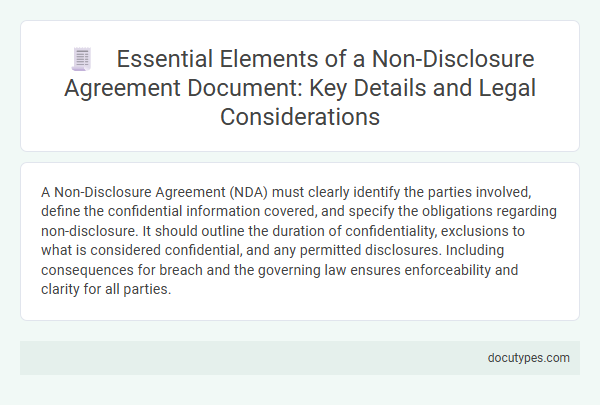A Non-Disclosure Agreement (NDA) must clearly identify the parties involved, define the confidential information covered, and specify the obligations regarding non-disclosure. It should outline the duration of confidentiality, exclusions to what is considered confidential, and any permitted disclosures. Including consequences for breach and the governing law ensures enforceability and clarity for all parties.
Introduction to Non-Disclosure Agreements
Non-Disclosure Agreements (NDAs) are legal contracts designed to protect sensitive information shared between parties. These agreements prevent unauthorized disclosure, ensuring confidentiality throughout the business relationship.
Your NDA must clearly define the confidential information, the obligations of each party, the duration of confidentiality, and any exclusions. Including specific terms helps safeguard intellectual property and maintain trust between involved entities.
Defining Confidential Information
Defining confidential information clearly is crucial in a Non-Disclosure Agreement (NDA) to protect sensitive data effectively. The scope of what constitutes confidential information must be explicitly outlined to avoid misunderstandings and legal disputes.
- Specificity - Clearly list the types of information considered confidential, such as business plans, financial data, and proprietary technology.
- Exclusions - Define which information is not confidential, like publicly available data or knowledge already known to the receiving party.
- Format and Medium - Specify that confidential information includes all formats, whether written, electronic, verbal, or otherwise communicated.
Parties Involved in the Agreement
Clearly identifying the parties involved in a Non-Disclosure Agreement (NDA) is essential for legal clarity and enforceability. Accurate details prevent confusion and ensure accountability between the entities exchanging confidential information.
- Full legal names - Specify the complete legal names of all individuals or organizations entering into the agreement to avoid ambiguity.
- Contact information - Include addresses, phone numbers, and email addresses for precise identification and communication.
- Roles and capacities - Define the capacity in which each party is participating, such as employer, contractor, or partner, to clarify responsibilities.
These details establish the foundation for effective confidentiality protection within the NDA document.
Purpose and Scope of Disclosure
What details must be included in the purpose and scope of disclosure section in a Non-Disclosure Agreement (NDA)? Clearly defining the purpose ensures that the confidential information is used only for specified objectives. The scope of disclosure outlines the type of information covered and limits how it can be shared or utilized.
Obligations and Responsibilities of Parties
A Non-Disclosure Agreement (NDA) must clearly define the obligations and responsibilities of the parties involved. This ensures both sides understand their duty to protect confidential information.
Obligations often include maintaining confidentiality, restricting the use of information to specific purposes, and preventing unauthorized disclosure. Parties are responsible for safeguarding sensitive data and notifying the other party if a breach occurs. Your NDA should specify the duration of these responsibilities to avoid ambiguity.
Duration and Term of the NDA
The duration and term are essential components of a Non-Disclosure Agreement (NDA) that define how long the confidentiality obligations last. Typically, the term specifies the start date, while the duration outlines the period during which the information must remain confidential. Ensure your NDA clearly states these timeframes to protect sensitive information effectively.
Exclusions from Confidentiality
An effective Non-Disclosure Agreement (NDA) clearly defines the scope of information considered confidential, including specific exclusions to avoid ambiguity. Understanding what details are excluded from confidentiality helps protect your rights and clarify obligations under the agreement.
- Information Already Public - Confidentiality does not apply to information that is or becomes publicly known through no breach of the NDA.
- Independently Developed Knowledge - Information independently created or discovered without reference to the confidential data is excluded.
- Disclosures Required by Law - Information that must be disclosed under legal or regulatory obligations is not protected by the NDA.
Consequences of Breach
| Detail | Description |
|---|---|
| Definition of Confidential Information | Clearly specifies what information is protected under the NDA, including trade secrets, business strategies, client data, and proprietary technology. |
| Parties Involved | Identifies all parties bound by the NDA to ensure responsibility and clarity on who is obligated to maintain confidentiality. |
| Obligations of Receiving Party | Outlines the duty to keep information confidential, restrict its use, and prevent unauthorized disclosure or dissemination. |
| Duration of Confidentiality | Specifies the time period during which the information must remain confidential, including post-termination obligations. |
| Consequences of Breach |
|
| Dispute Resolution | Methods for handling conflicts arising from breaches, such as arbitration or jurisdiction for legal proceedings. |
Governing Law and Jurisdiction
The governing law clause in a Non-Disclosure Agreement (NDA) specifies which jurisdiction's legal framework will interpret and enforce the agreement. This detail ensures clarity and predictability in case of disputes related to confidentiality obligations.
Jurisdiction defines the location where any legal action or litigation regarding the NDA must be filed and resolved. Including precise jurisdiction terms helps prevent conflicts over venue and supports efficient dispute resolution.
What Details Must Be Included in a Non-Disclosure Agreement (NDA) Document? Infographic

